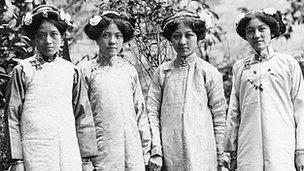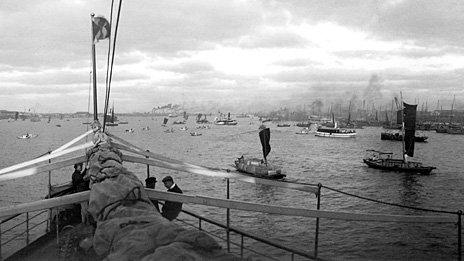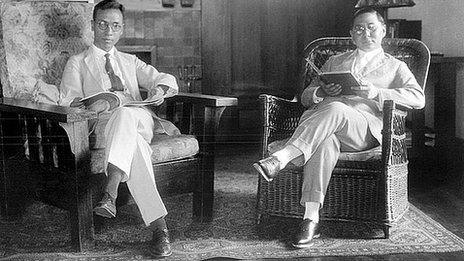The search for photos of China's past
- Published
China's photographic record begins only in the 1970s because nearly all earlier pictures were destroyed. The ones that survived are mostly outside China, and a major effort is now under way to bring them together online, says the BBC's Mary Ward-Lowery.
Twelve years ago a student from Peking University knocked on Robert Bickers' door.
He'd come, he said, to study Keats, but he knew Professor Bickers was a historian, a specialist in Sino-British relations at Bristol University.
The student had been given a travel grant to come to the UK, with specific instructions to find historical photographs of Peking University. "Because we don't have any," his Chinese professors told him.
Old photograph fever is currently sweeping China. A new and intense appetite for images of the country's past has resulted in a publishing phenomenon - sales of books of historical photographs have rocketed.

Such photographs are exceptionally rare in China. The turbulent history of the 20th Century meant that many archives were destroyed by war, invasion and revolution. Mao Zedong's government regarded the past as a "black" time, to be erased in favour of the New China. The Cultural Revolution of the late 1960s finished the job.
"If you were at all savvy," says Bickers, "you realised early on that you had to destroy your own private family records, before the Red Guards came and found evidence of your bourgeois, counter-revolutionary past, when you might have drunk coffee in a café bar, à la mode."
Holiday snapshots, studio portraits of weddings and babies, all were dangerously incriminating. So people destroyed their own family collections, rubbing out over 150 years of photographic history in the process.
But now China is opening its horizons, looking to the West and to the past, to reclaim its cosmopolitan history.
After the Tiananmen Square protests of 1989, Chinese leaders concluded that young people did not fully appreciate what the Communist Party had done for China, so they began an ambitious new policy of historical education, the Patriotic Education Movement. The craze for old photographs is partly a by-product of this movement.
But such photographs are not to be found in China. They are in the attics and wardrobes of foreigners - many British - whose families once lived and worked in China and who took their photographs safely out of the country when they left.
Bickers is leading <link> <caption>a project to collect the photographs and make them freely available</caption> <altText>Historical Photos of China website</altText> <url href="http://hpc.vcea.net/" platform="highweb"/> </link> . It started when he put online a list of 2,000 British policemen who had worked in the Shanghai Municipal Police.
Relatives contacted him to find out more, attaching photographs. Bickers was astonished. "There were photos of Chinese society, culture and people that I have never seen before. I had never seen anything like them," he says.

These women were pictured in 1910 Hong Kong
Now the photographs arrive from all sorts of people and places, ranging across every possible subject and every part of China.
The British - businessmen, missionaries, customs officers and police - were everywhere, even in remote places where very few people even possessed a camera.
Some collections, like those of Tita Hayward and Audrey Gregg, record a childhood of privilege and frivolity spent mostly in the company of servants, as their parents attended to business and a hectic social life.
There are unintentionally controversial photographs by policeman William Armstrong, depicting plump and contented peasants in the 1920s, whereas communist propaganda suggested they were starving and unhappy.
G Warren Swire's collection records the trading interests of John Swire & Sons. His photographs of warehouses and dockyards might be thought dull were it not for Swire's careful - and beautiful - compositions and the fact that most of these landscapes no longer exist.
Rapid urban development in China has meant that historic buildings and neighbourhoods have been swept away and replaced with skyscrapers. They exist now only in people's memories or in these photographs.

Few photos exist of shipping in Shanghai in the early 1900s
One of the treasures of the collection, however, is a set of photographs taken by a Chinese politician and diplomat, Fu Bingchang. Fu was a talented amateur photographer and his subjects just happen to include the Kuomintang elite.
When the Nationalist government fell in 1949, Fu was sent into exile but before he left he arranged for his papers to be smuggled to France.
Fu never saw them again but in the early 70s, his son Johnny received a phone call from Fu's former secretary, Chen Ding, inviting him to his house in St Cloud, the Paris suburb where he'd lived for the past 20 years.
Johnny discovered a dozen leather suitcases full of photographs, diaries and paintings, an incredible treasure trove, a gift from his father.
"I was 12 years old and living in Macao when the Japanese attacked," recalls Johnny, now 83 and living in Lancashire in the UK.
"We had to run away because of my father's position. We had to walk for seven days non-stop, drinking water from paddy fields.
"I was lucky to be alive, lucky to carry the clothes on my back, so we were very lucky to be able to salvage the photos."

Fu Bingchang (left) was a senior diplomat and keen photographer
Bickers calculates that one British person in 10 has some historical connection to China and he wants their photographs to add to the online collection.
"These photos are an inadvertent legacy of that period of national humiliation, of British supremacy in China.
"I feel strongly that this is an act of historical restitution, giving back to China something that's now here, that was taken."
<italic>The slideshow at the top of the page includes the voices of Tita Hayward and Audrey Gregg (who as children both lived in China), Robert Bickers and Jamie Carstairs from the University of Bristol, and Foo Chung Hung (Johnny) and Yee Wah Foo (son and granddaughter of Chinese diplomat Fu Bingchang). </italic>
<italic>All images subject to copyright. Click on bottom right icon for captions. Music by KPM Music. Slideshow by Paul Kerley. Publication date 11 July 2012.</italic>